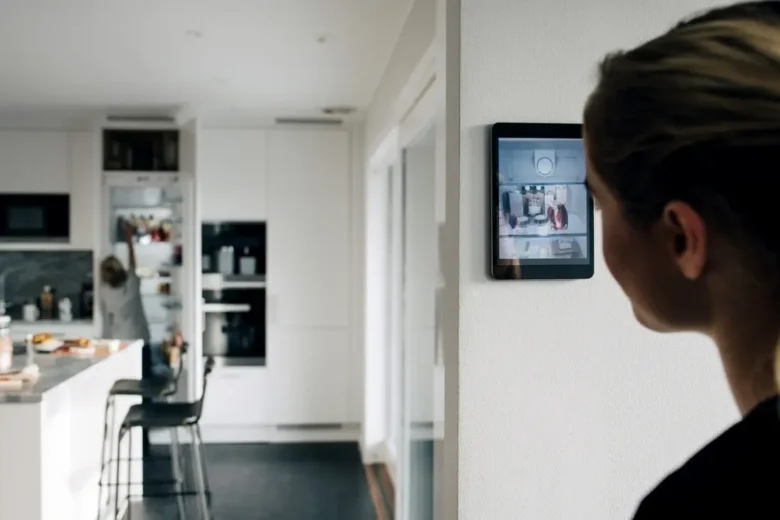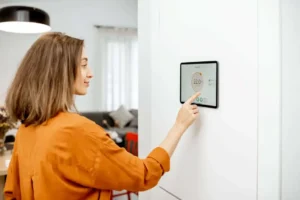We enjoy smart homes with voice-controlled lighting, thermostats that remember our actions, and remote surveillance cameras. While these technologies make life easier, they also raise a critical question: Are they watching us more than we think? The chances that your smart home is spying on you and collecting more data than you realize are growing.
With devices from refrigerators to doorbells equipped with microphones, cameras, and internet connections, it’s no wonder people are scared. Connectivity can heighten your vulnerability. Does the convenience outweigh the privacy risks? This article explores how smart home devices collect data, where it goes, and how it manages your digital life. Discover the hidden aspects of your smart home.
Data Collection by Smart Devices:
Every smart home device collects data—that’s just the way it works. A smart thermostat analyzes your daily schedule to heat or cool your home more efficiently. A wake word alerts your smart speaker to a command. Your smart TV can track what you watch to recommend shows or show you personalized ads. How much is too much? These devices often record your voice, location, and usage habits without you even knowing it. These devices require microphones, cameras, motion sensors, and Wi-Fi. Your data can be stored in the cloud, evaluated by computers, and sold to third-party advertisers. Most organizations claim that this knowledge improves service or personalizes your experience, but it means you’re constantly being watched at home. To restore your privacy, you first need to understand how your smart devices work.
Who Can See Your Smart Home Data?
Your smart devices can gather data, but it’s crucial to understand who can access it. Who can access it? While most users believe their data is private, it can extend far beyond their living room. Manufacturers, app developers, cloud storage providers, and third-party marketers may have access to your data. Some law enforcement agencies may legally request it. Installing new apps, accepting updated terms, or connecting more devices extends this chain of access. Worse, many smart home technologies make it difficult to understand where your data lives or how it’s being used. If you don’t dig into the settings or read the fine print, you could inadvertently grant broad permissions during the setup process and not realize how much personal information is being shared. This lack of transparency exposes your home to silent intruders who may want to take advantage of your daily life.
Risk of Hacking and Unauthorized Surveillance:
The constant connectivity of smart devices makes them useful but also risky. Hackers can gain access to your baby monitor and security system via your Wi-Fi network. This scenario isn’t fantasy—it’s happened countless times. Strangers have hacked into webcams to spy on your home or voice assistants to make illegal requests. The more connected devices you have, the more entry points there are for cybercriminals. Be aware that some devices have weak default passwords, outdated software, or no security updates, making your home an accessible target. Hackers have even targeted well-known brands. It’s creepy and illegal to let someone spy on your smart TV or smart speaker. Strong passwords, two-factor authentication, and regular updates are essential to keeping your device secure.
Targeted Ads and Data Usage:
Have you ever wondered why you see ads related to topics you briefly mentioned? This strange feeling may not be a coincidence. Smart home devices can learn about your behavior, preferences, and discussion trends, not just your orders. Companies use this information to build a digital profile of you and show you highly targeted ads. Your smart speaker may recommend products you never searched for but mention occasionally, while your smart TV may recommend content based on your viewing history and web activity. Personalization sounds wonderful, but it often compromises your privacy. This information can be sold to third-party advertisers or combined with data from your phone, laptop, and other apps to create a complete lifestyle profile. Your home becomes a marketplace, and you become a product. Understanding this trade-off can help you decide how much information you share for your convenience.
Privacy in Your Smart Home:
Risks are real, but you don’t have to give up your smart home. With a few simple choices, you can take back your privacy. Choose products from brands you trust that offer solid security measures. Change default passwords and use two-factor authentication where possible. Regularly review device permissions and privacy settings—disable data sharing and voice recording when not needed. Set up a separate Wi-Fi network for your smart devices to isolate them from your primary internet connection. Regularly update your software and firmware to fix security issues. If you’re worried about eavesdropping, use devices with manual camera protection or physical mute buttons. Finally, read the privacy policy—it’s boring, but it clearly states what data is being collected and used. Be careful to secure your home, not monitor it.
Conclusion:
Smart homes should be places of privacy, not silent spectators. While these technologies are useful and innovative, they also come with problems that can’t be ignored. Understanding how smart devices collect, distribute, and use data can help you make smart choices. Be aware, not afraid. With the right steps, you can have a connected home without sacrificing your privacy. Stay up-to-date and in control. Protect and support devices to prevent them from becoming hidden intruders. Take action now to make your smart home as smart as you want it to be.
FAQs:
1. Can my smart speaker always hear me?
Smart speakers can only listen for wake words, but accidental recordings can be sent to cloud servers for analysis. You can view and delete recordings through the device settings.
2. How do you know if a smart device has been hacked?
Abnormal device behavior, unusual network login messages, and sounds from smart speakers or cameras are all signs of hacking. Regularly review your device’s logs and change your password if you notice suspicious activity.
3. Does the privacy policy provide accurate information?
However, privacy policies often use complex legalese. The best way to understand data collection, use, and sharing is through privacy policies.
4. Which smart device is the most secure?
There is no single answer, but products from companies with a good reputation for security, regular upgrades, and transparent policies are more trustworthy.
5. Is it worth protecting my privacy if I give up smart devices?
Not necessarily. When using smart technology, be sure to take care of privacy and use strong passwords, network segmentation, and careful permission settings.




